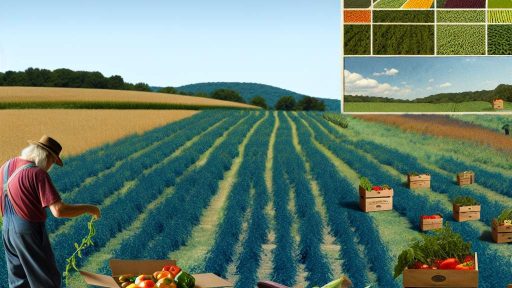Understanding Organic Farming Principles and Practices
Defining Organic Farming
Organic farming emphasizes sustainability and ecological balance.
It avoids synthetic fertilizers and pesticides.
This practice promotes biodiversity and soil health.
Farmers adhere to natural processes and cycles.
Key Principles of Organic Farming
Soil health is crucial in organic farming.
Healthy soil enhances crop growth and resilience.
Another principle involves crop rotation.
Crop rotation prevents soil depletion and manages pests.
Furthermore, organic farming relies on biodiversity.
Diverse plants foster a balanced ecosystem.
Practices to Embrace
Companion planting is a practical technique for organic farmers.
This method enhances pest control and soil health.
Cover crops play an essential role as well.
They protect soil, prevent erosion, and fix nitrogen.
Additionally, using natural pest control methods is vital.
Transform Your Agribusiness
Unlock your farm's potential with expert advice tailored to your needs. Get actionable steps that drive real results.
Get StartedBeneficial insects can manage pest populations effectively.
Understanding Regulations and Certifications
Familiarize yourself with organic standards in your area.
Compliance ensures your products meet regulatory requirements.
Obtaining certification builds credibility with consumers.
Research the application process and necessary documentation.
Benefits of Organic Farming
Organic farming offers numerous benefits for farmers and consumers.
It leads to healthier food options free of chemicals.
Moreover, organic practices enhance environmental health.
Soil and water quality improve through sustainable techniques.
Choosing the Right Location for Small-Scale Organic Farming
Understanding Your Climate
Climate plays a crucial role in farming success.
Your chosen location should suit the types of crops you wish to grow.
Consider temperature, rainfall, and frost dates when selecting your site.
Research local climate patterns to make informed decisions.
Soil Quality Assessment
Healthy soil is the backbone of organic farming.
Test the soil for pH levels and nutrient content.
Look for well-draining soil, rich in organic matter.
Consider adding compost or organic fertilizers to enhance soil health.
Accessibility and Infrastructure
Your location should be easily accessible for equipment and supplies.
Proximity to markets can influence your farm’s profitability.
Ensure there are adequate roads and utilities like water and electricity.
Building a network of local suppliers can also be beneficial.
Legal and Regulatory Considerations
Familiarize yourself with zoning laws and agricultural regulations.
Check for any restrictions related to organic farming in your area.
Understand local guidelines for waste management and pesticide use.
Showcase Your Farming Business
Publish your professional farming services profile on our blog for a one-time fee of $200 and reach a dedicated audience of farmers and agribusiness owners.
Publish Your ProfileComplying with regulations can save you from future headaches.
Community and Support Networks
Engage with local farming communities for support and knowledge-sharing.
Join agricultural associations or cooperative groups in your region.
Networking can provide useful resources and partnerships.
Additionally, communities often offer educational programs for farmers.
Soy Health
Importance of Testing Soil
Testing your soil is essential for successful farming.
This practice helps you identify nutrient deficiencies.
It also determines pH levels and soil texture.
Understanding these factors enables you to make informed decisions.
For instance, different crops require specific soil conditions.
Thus, knowing your soil type can greatly impact crop yield.
Moreover, regular testing allows timely interventions.
Improving Soil Quality
Improving soil quality is a continual process.
Start by adding organic matter to your soil.
Compost, manure, and cover crops enhance soil structure.
These amendments improve moisture retention and aeration.
Additionally, practicing crop rotation prevents nutrient depletion.
This method helps disrupt pest and disease cycles.
Utilizing Mulch
Applying mulch significantly enhances soil health.
Mulch retains moisture and suppresses weeds.
It also adds organic matter as it decomposes.
This practice encourages beneficial microorganisms in the soil.
Minimizing Soil Disturbance
Reducing soil disturbance promotes soil health.
Consider using no-till or reduced-till methods.
These techniques maintain soil structure and prevent erosion.
As a result, soil ecosystems thrive and improve fertility.
Monitoring Soil Health Regularly
Regular monitoring helps maintain soil quality.
Keep records of your soil tests and amendments.
This practice shows you what works best for your crops.
Over time, you’ll notice trends and make better decisions.
Uncover the Details: Farm-To-Table Events for Community-Supported Agriculture Promotion
Selecting Appropriate Crops for Organic Farming Beginners
Understanding Local Climate and Soil
Start by evaluating your local climate and soil type.
This assessment influences crop selection significantly.
Consider temperature extremes and rainfall patterns in your area.
Additionally, test your soil for nutrients and pH levels.
Choosing Easy-to-Grow Crops
Begin with crops that are relatively easy to grow.
These crops will boost your confidence and experience.
- Lettuce requires minimal care and grows quickly.
- Radishes mature fast, providing a quick harvest.
- Beans enrich the soil through nitrogen fixation.
- Herbs like basil and mint thrive in various conditions.
Considering Market Demand
Research local market trends to understand crop demand.
Focus on producing what consumers are interested in buying.
Visit local farmers’ markets for insights and inspiration.
Showcase Your Farming Business
Publish your professional farming services profile on our blog for a one-time fee of $200 and reach a dedicated audience of farmers and agribusiness owners.
Publish Your ProfileNetwork with other local farmers to exchange ideas.
Implementing Crop Rotation
Practice crop rotation to improve soil health over time.
This method enhances soil fertility and prevents pests.
Change crops in the same area for each planting season.
Rotate between legumes and leafy greens for best results.
Utilizing Companion Planting
Explore the benefits of companion planting.
This technique involves pairing beneficial plants together.
For example, tomatoes and basil grow well side by side.
Companion planting can enhance flavors and deter pests.
Delve into the Subject: Urban Farming Business Plan Development for Sustainable Growth
Effective Pest Management Strategies in Organic Farming
Understanding Integrated Pest Management
Integrated Pest Management (IPM) combines various strategies to control pests effectively.
This approach emphasizes using natural predators and biological controls.
Moreover, it encourages monitoring pest populations to determine action thresholds.
Utilizing Beneficial Insects
Beneficial insects play a crucial role in pest management.
Ladybugs and lacewings are excellent for controlling aphid populations.
Additionally, predators like parasitic wasps can help manage caterpillars.
Employing Companion Planting
Companion planting involves growing different plants together for mutual benefit.
Certain plants can repel pests while attracting beneficial insects.
For example, marigolds are known to deter nematodes and other pests.
Implementing Cultural Practices
Cultural practices are vital for maintaining healthy crops and preventing pest infestations.
Rotating crops disrupts pest life cycles and reduces their populations.
Furthermore, maintaining proper soil health enhances plant resistance to pests.
Natural Pest Deterrents
Natural pest deterrents can be effective in organic farming.
Neem oil is a popular option for repelling a variety of pests.
Garlic and chili sprays also deter many insects without harming beneficial species.
Regular Monitoring and Maintenance
Regular monitoring is essential for successful pest management.
Farmers should inspect crops frequently for signs of pest activity.
Maintaining clean fields helps reduce pest habitats and breeding grounds.
Learn More: Best Soil Practices for Cultivating Heirloom Vegetable Crops

Water Management Techniques for Sustainable Organic Farming
Understanding Water Needs
Identify the specific water requirements for your crops.
Different plants have varying water needs.
Understand the growth stages of plants to optimize watering.
Consider local climate conditions that may affect water absorption.
Implementing Efficient Irrigation Systems
Use drip irrigation to target root zones directly.
This method conserves water and reduces weeds.
Explore rainwater harvesting to supplement your water supply.
Installing rain barrels captures runoff efficiently.
Soil Moisture Monitoring
Invest in soil moisture sensors for precise watering.
These sensors help you avoid over-watering or under-watering.
Regularly check soil moisture levels to adjust irrigation schedules.
Showcase Your Farming Business
Publish your professional farming services profile on our blog for a one-time fee of $200 and reach a dedicated audience of farmers and agribusiness owners.
Publish Your ProfileObserve the moisture retention properties of different soil types.
Encouraging Water Conservation Practices
Practice mulching to retain soil moisture.
Organic mulches reduce evaporation and suppress weeds.
Promote crop rotation to enhance soil health and moisture retention.
Consider cover crops to protect soil and improve water absorption.
Utilizing Natural Resources Wisely
Direct excess water from one area to another using swales.
Designing contour beds allows for better water flow management.
Integrate plant species that thrive on varying moisture levels.
Create small ponds to store water and attract beneficial wildlife.
Explore Further: How Smart Storage Techniques Prevent Spoilage And Bolster Farm Profit Margins
Utilizing Composting and Organic Fertilizers for Crop Production
Understanding Composting
Composting transforms organic waste into nutrient-rich soil amendment.
This process recycles kitchen scraps and yard debris effectively.
Compost enriches soil and improves its structure and aeration.
Moreover, it aids in moisture retention, which benefits plant growth.
Benefits of Organic Fertilizers
Organic fertilizers enhance soil fertility naturally.
They release nutrients slowly, providing steady nourishment to plants.
This minimizes the risk of nutrient leaching, which harms water quality.
Additionally, organic fertilizers support microbial life in the soil.
Types of Organic Fertilizers
- Animal manure enriches soil with nitrogen and phosphorus.
- Bone meal provides a robust source of phosphorus for root development.
- Fish emulsion offers plants a balanced range of nutrients.
- Worm castings improve microbial health and enhance nutrient availability.
Implementing Composting at Home
Start by collecting organic waste in a compost bin.
Create layers of greens and browns for balanced carbon-nitrogen levels.
Regularly turn the compost to aerate and speed up decomposition.
Monitor moisture levels to ensure optimal composting conditions.
Integrating Organic Fertilizers into Farming Practices
Incorporate organic fertilizers at the beginning of the planting season.
Apply them according to soil test recommendations for best results.
Consider side-dressing during the growing season for additional nutrients.
Use organic fertilizers in combination with compost for enhanced benefits.
Monitoring Soil Health
Regular Soil Testing
Test soil regularly to understand nutrient content and pH levels.
This helps in adjusting the type and amount of organic fertilizers used.
Observing Plant Responses
Watch how plants respond to organic fertilizers over time.
Healthy growth indicates the effectiveness of your fertilization strategy.
Marketing Your Organic Produce
Understanding Your Target Market
Identifying your target market is crucial.
Research local preferences to shape your offerings.
Consider demographics such as age, lifestyle, and health consciousness.
Additionally, understanding market trends can guide your approach.
Building a Strong Brand
Your brand tells customers who you are.
Create a unique name that resonates with your values.
Design attractive packaging to highlight your organic produce.
Furthermore, consistency in branding builds trust with customers.
Using Social Media Platforms
Social media is a powerful marketing tool.
Engage with potential customers through posts and stories.
Showcase Your Farming Business
Publish your professional farming services profile on our blog for a one-time fee of $200 and reach a dedicated audience of farmers and agribusiness owners.
Publish Your ProfileShare the story behind your farm and produce.
Also, use visually appealing images to showcase your products.
Participating in Local Markets
Farmers’ markets are excellent for visibility.
They connect you directly with customers in your community.
Prepare samples to entice potential buyers.
Moreover, interact with customers to build relationships.
Establishing a Website
A professional website enhances your credibility.
Include an online store for convenience.
Provide detailed information about your farming practices.
Additionally, feature testimonials to build trust.
Networking and Collaborations
Connect with local businesses for cross-promotion.
Partnering with restaurants can create exclusive menu items.
Furthermore, join local farming associations for support.
Networking helps share valuable insights and resources.
Additional Resources
Waiting for the Dirt – Oxford American
Farm to Table: Building Local and Regional Food Systems – SARE




